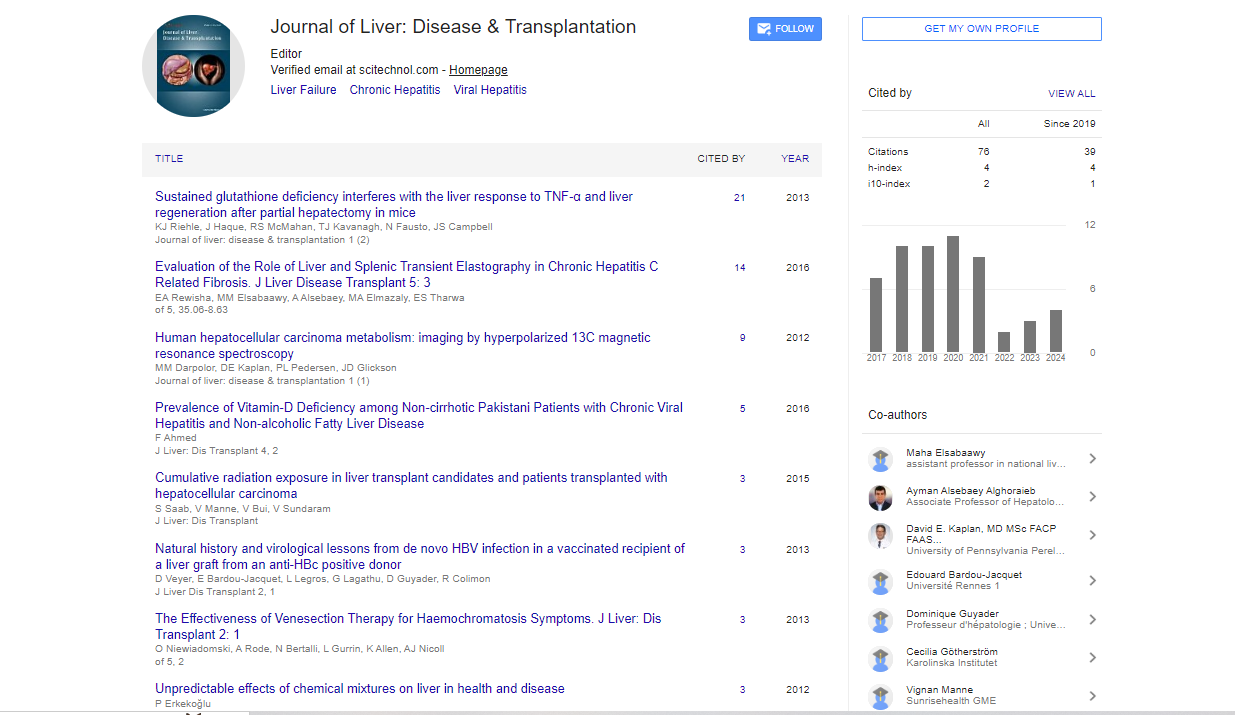Opinion Article, J Liver Disease Transplant Vol: 13 Issue: 3
Advances in Non-Invasive Diagnostic Techniques for Early Detection of Liver Fibrosis and Cirrhosis
Ethan Davis*
1Department of Hepatology, University of Toronto, Toronto, Canada
*Corresponding Author: Ethan Davis,
Department of Hepatology, University of Toronto, Toronto, Canada
E-mail: ethan.davis@utoronto.ca
Received date: 26 August, 2024, Manuscript No. JLDT-24-151919;
Editor assigned date: 28 August, 2024, PreQC No. JLDT-24-151919 (PQ);
Reviewed date: 11 September, 2024, QC No. JLDT-24-151919;
Revised date: 18 September, 2024, Manuscript No. JLDT-24-151919 (R);
Published date: 25 September, 2024, DOI: 10.4172/2325-9612.1000274
Citation: Davis E (2024) Advances in Non-Invasive Diagnostic Techniques for Early Detection of Liver Fibrosis and Cirrhosis. J Liver Disease Transplant 13:3.
Description
Liver fibrosis and cirrhosis represent a progressive continuum of liver damage that can lead to severe complications and increased mortality rates. Early detection of these conditions is essential for effective management and treatment, as timely interventions can significantly slow the progression of liver disease, prevent complications and improve patient outcomes. Traditionally, liver biopsy has been the gold standard for diagnosing liver fibrosis and cirrhosis, but this invasive approach poses risks, is costly and is limited by sampling variability. Over recent decades, significant advances in non-invasive diagnostic techniques have emerged, providing alternatives that improve early detection accuracy, patient safety and overall diagnostic efficiency. Fibrosis, the excessive accumulation of extracellular matrix proteins, gradually disrupts normal liver structure. If left untreated, it can lead to cirrhosis, an irreversible scarring of the liver associated with liver dysfunction, portal hypertension and risk of liver cancer. Early detection is important because fibrosis is potentially reversible in its early stages, whereas cirrhosis is often irreversible and requires more intensive management, including liver transplantation in severe cases. Noninvasive techniques, therefore, aim to facilitate early diagnosis to reduce progression, improve quality of life and reduce healthcare costs associated with end-stage liver disease.
One of the primary advancements in non-invasive diagnostics for liver fibrosis and cirrhosis is the use of serum biomarkers. Serum biomarkers measure specific proteins, enzymes, or molecules that are indicative of liver inflammation and fibrosis. While serum biomarkers provide a convenient and cost-effective approach, they have limitations in distinguishing intermediate stages of fibrosis and may be influenced by other factors like inflammation or fatty liver disease. Non-invasive imaging techniques have revolutionized liver disease diagnostics, allowing for detailed liver visualization without the need for biopsies. The primary imaging modalities include transient elastography, magnetic resonance elastography and shear wave elastography. These imaging techniques offer an important advancement over traditional biopsy, providing quick, safe and repeatable measures of liver stiffness, an important surrogate for fibrosis. Imaging also allows for ongoing monitoring, which is essential for managing chronic liver diseases. Recent studies suggest that combining serum biomarkers with imaging techniques may improve diagnostic accuracy. Composite scores that integrate multiple biomarkers or pair biomarkers with imaging findings are particularly effective in ruling out significant fibrosis and may reduce the need for liver biopsies in many cases.
Such combined approaches are increasingly used in clinical guidelines to enhance decision-making accuracy and reduce uncertainties, thus minimizing the need for invasive procedures. Additionally, the combination of serum markers with imaging data can help provide a more comprehensive assessment of disease progression over time. Artificial Intelligence (AI) and machine learning algorithms are starting to play an instrumental role in liver diagnostics, particularly when analyzing complex data from imaging modalities and biomarker assays. AI can assist in detecting patterns that may be indicative of early-stage fibrosis, often invisible to the human eye. Machine learning models, trained on large datasets of liver disease cases, have demonstrated potential in predicting fibrosis and cirrhosis severity, as well as in estimating disease progression rates. These tools provide enhancing diagnostic accuracy, especially in borderline or ambiguous cases and may become integral to liver disease management in the near future. Despite these advancements, challenges remain in implementing non-invasive techniques universally. High costs and limited access to advanced imaging modalities like MRE in certain regions are obstacles that need to be addressed. Additionally, while non-invasive methods show high sensitivity and specificity for advanced fibrosis and cirrhosis, detecting mild fibrosis remains challenging, which may limit early intervention in some cases. To overcome these limitations, continued study is required to refine existing techniques and develop new biomarkers that are more sensitive to early fibrosis.
Conclusion
Non-invasive diagnostic techniques for liver fibrosis and cirrhosis represent a major leap forward in hepatology. Serum biomarkers, advanced imaging modalities and AI-powered diagnostics provide safer, more accessible and accurate alternatives to liver biopsy. Early detection facilitated by these technologies is key to improving prognosis and quality of life for patients with liver disease. As technology and study continue to progress, non-invasive diagnostics will likely become the foundation of liver disease management, providing physicians with powerful tools for early intervention and personalized treatment.
 Spanish
Spanish  Chinese
Chinese  Russian
Russian  German
German  French
French  Japanese
Japanese  Portuguese
Portuguese  Hindi
Hindi 